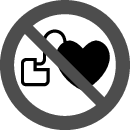Safety instructions for cordless worklights

Read all the safety and general instructions. Failure to observe the safety and general instructions may result in electric shock, fire and/or serious injury.
Keep all the safety and general instructions for future reference.
- Please read and observe all safety and general instructions included with the battery or with the power tool supplied with the battery.
- Handle the worklight with care. The worklight produces intense heat which increases the risk of fire and explosion.
- Do not work with the worklight in potentially explosive areas.
- Do not continue to press the On/Off switch after the worklight has been automatically switched off. The battery can be damaged. Ensure that the battery is charged and that the worklight has cooled before switching on the worklight again.
- Use only original Bosch accessories.
- The light source cannot be replaced. If the light source is defective, the entire cordless worklight must be replaced.
- Remove the batteries from the worklight before carrying out any work on the worklight (e.g. assembly, maintenance, etc.) as well as when transporting and storing the worklight. There is risk of injury from unintentionally pressing the on/off switch.
- Do not direct the light beam at persons or animals and do not stare into the light beam yourself (even from a distance).
- Do not use the worklight in road traffic. The worklight is not permitted for illumination in road traffic.
- Do not cover the lamp head while the cordless worklight is operating. The lamp head warms up during operation and can cause burns if this heat accumulates.
- Store idle cordless worklights out of the reach of children. Do not allow persons unfamiliar with the cordless worklight or these instructions to operate the tool. Cordless worklights can be dangerous in the hands of untrained users.
- In case of damage and improper use of the battery, vapours may be emitted. The battery can set alight or explode. Ensure the area is well ventilated and seek medical attention should you experience any adverse effects. The vapours may irritate the respiratory system.
- If used incorrectly or if the battery is damaged, flammable liquid may be ejected from the battery. Contact with this liquid should be avoided. If contact accidentally occurs, rinse off with water. If the liquid comes into contact with your eyes, seek additional medical attention. Liquid ejected from the battery may cause irritation or burns.
- The battery can be damaged by pointed objects such as nails or screwdrivers or by force applied externally. An internal short circuit may occur, causing the battery to burn, smoke, explode or overheat.
- When the battery is not in use, keep it away from paper clips, coins, keys, nails, screws or other small metal objects that could make a connection from one terminal to another. A short circuit between the battery terminals may cause burns or a fire.
- Do not open the battery. There is a risk of short-circuiting.
| Protect the battery against heat, e.g. against continuous intense sunlight, fire, dirt, water and moisture. There is a risk of explosion and short-circuiting. |
- Only charge the batteries using chargers recommended by the manufacturer. A charger that is suitable for one type of battery may pose a fire risk when used with a different battery.
- Only use the battery in the manufacturer's products. This is the only way in which you can protect the battery against dangerous overload.
|
| Keep the cordless worklight away from implants and other medical devices, e.g. pacemakers or insulin pumps. The magnet inside the cordless worklight generates a field that can impair the function of implants and medical devices. |
- Keep the cordless worklight away from magnetic data storage media and magnetically-sensitive devices. The effect of the magnet can lead to irreversible data loss.
- Do not fix the cordless worklight overhead using the magnetic mount. There is a risk of injury if it falls down.
- Check to ensure that the magnetic mount can securely hold the cordless worklight. There is a risk of injury if it falls down.


